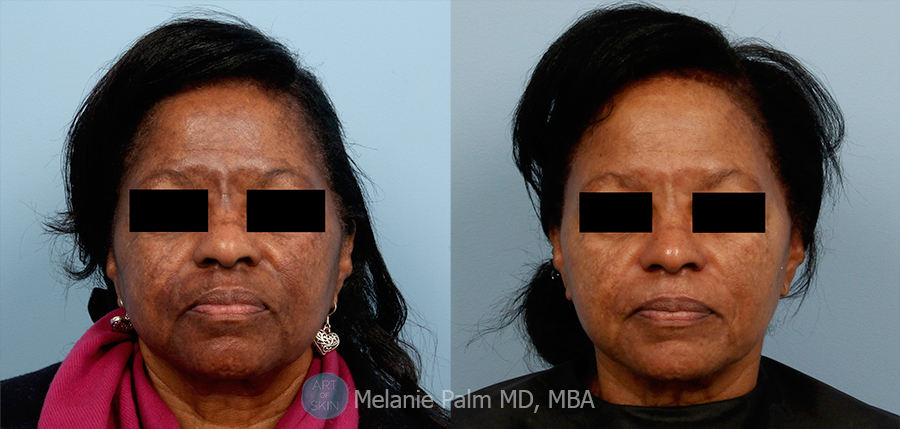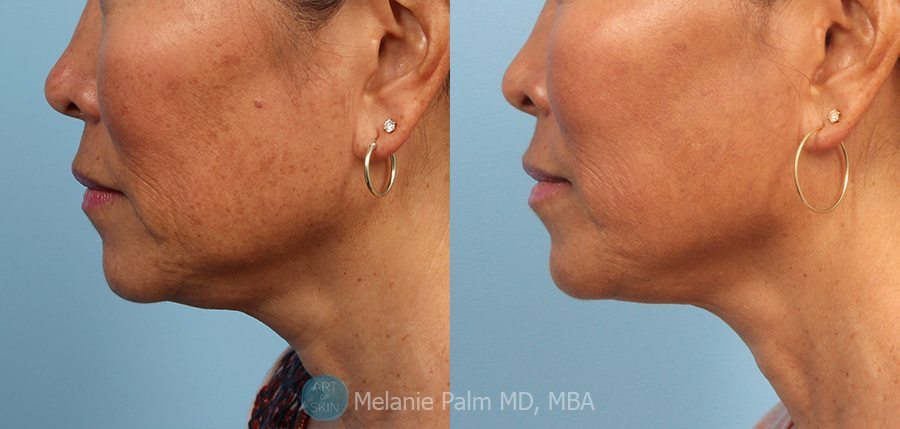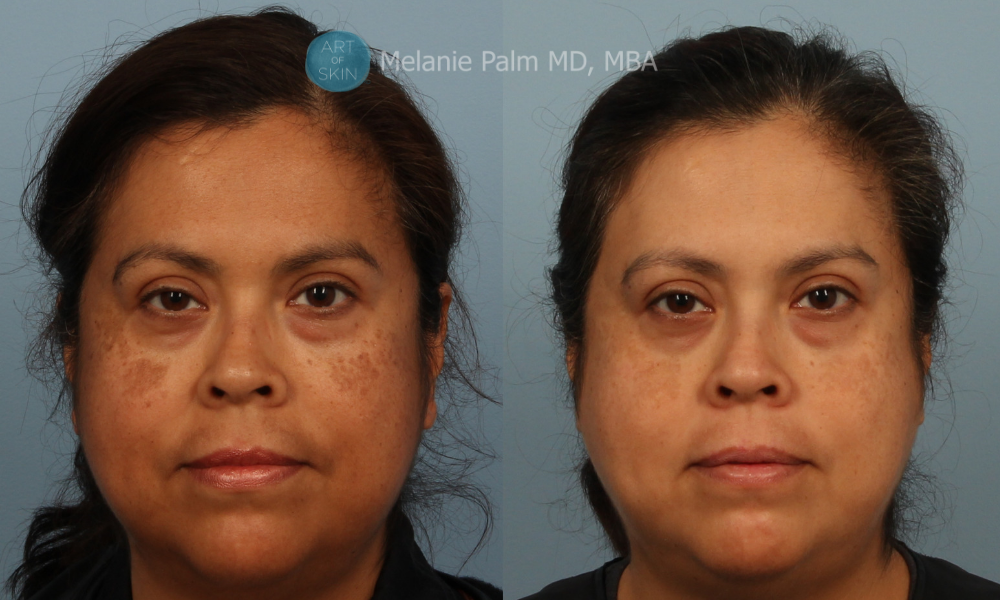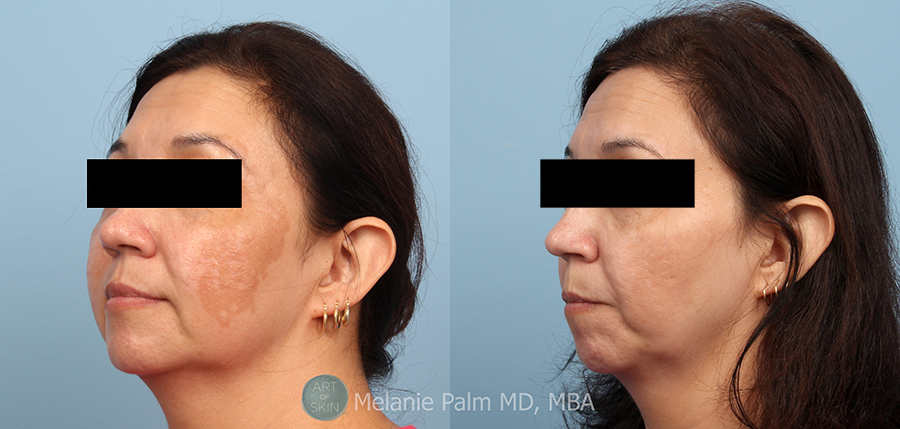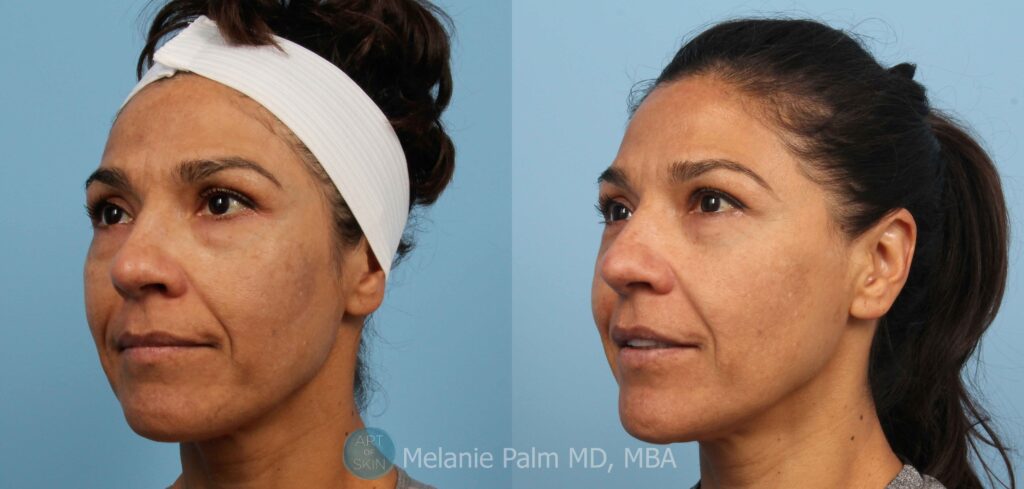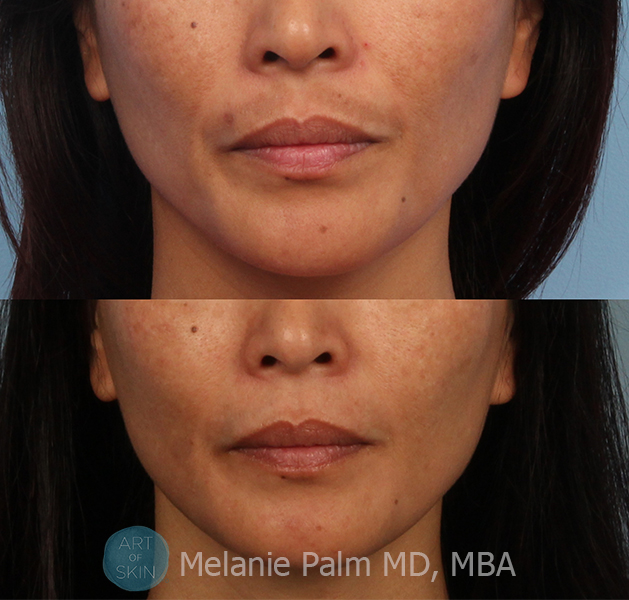Sun Damage and Brown Spots
Dr. Melanie Palm is a nationally recognized dermatologist and cosmetic surgeon specializing in the treatment of sun damage, age spots, and brown spots. Her offices are located in Solana Beach, CA just north of San Diego. Dr. Palm lectures nationally on facial rejuvenation for sun damage and pigmentation. She offers many effective treatment options for age spots.
What are Sun Damage and Brown Spots? What causes these skin changes?
Sun exposure, ultraviolet light, tanning booths, environmental exposure, genetics, and the passage of time all lead to aging changes in the skin. Of the UV spectrum of light, the UVA portion plays the greatest role in aging, In fact, now it is appreciated that 10-20% of aging related changes from the skin aren’t from UV exposure, but rather from infrared light and visible light.
Aging changes in the skin manifest themselves by changes in its structure: skin cells, blood vessels, and collagen. The skin becomes discolored with brown or white spots, blood vessel damage results in telangiectasias, and collagen damage causes wrinkles, textural changes, and sallowness (yellow discoloration to the skin). Common signs of sun damage on the skin include the following:
- Freckles (ephelides): light brown spots that darken with sun exposure
- Sun spots (solar lentigines): brown spots that are always present and do not darken with sun exposure
- Melasma: these brown patches on the skin overwhelming affect women and are due to a complex interplay between hormones, sun exposure, and inflammation. They are common during pregnancy and with birth control or hormonal replacement therapy.
- Seborrheic keratoses: SK’s are benign stuck-on skin thickenings that may appear skin-colored to very dark brown and are in greater number in areas of sun exposure
- Idiopathic guttate hypomelanosis (IGH): appears as white dots on heavily sun damaged areas
- Broken capillaries (telangiectasias): broken blood vessels called vascular ectasia occurs when UV exposure damages vessel walls
- Coarse skin texture: age, weather, and sunlight all cause permanent changes in the collagen and elastin that provides structure and bounce back to our skin
- Wrinkles (rhytids): some are formed by muscle movement over time, but many wrinkles are the result of collagen and skin destruction by UV and the elements over time
- Yellow discoloration (sallowness): resulting from blood vessel and collagen damage to the skin
- Skin thinning (atrophy): normal aging results in skin thinning but can be accelerated by sun and UV exposure
- Easy bruising: results from chronic sun damage resulting in fragile vessels and thin skin
- Severe sun damage (dermatoheliosis): the most severe form of sun damage, the skin appears waxy, heavily and deeply wrinkled, yellow, and may have large blackheads present
Treatment Options for Sun Damage and Brown Spots
The correct choice or combination of treatment options for aging changes in the skin depend on the underlying issue and cause of skin damage.
The following treatments are commonly used alone or in combination for sun damage and age spots:
- Medical therapy: medications are commonly used to prevent, control and to some extent reverse the signs of skin aging:
- Sunscreen: photoprotection is part of a proactive means to prevent further UV exposure, sun damage, and the development of precancerous spots.
- Retinoids: prescription-strength vitamin A derivatives such as tretinoin (Retin-A) or tazarotene have been shown to decrease the number and severity of AKs from research dating back to the 1980s.
- Cosmeceuticals: physician-grade topical skin care products used at home can greatly improve the appearance of the skin. Glycolic acid, vitamin C, and growth factors are just some of the active ingredients that can improve the appearance of the skin.
- Brightening agents: hydroquinone, kojic acid, vitamin C , and products like Lytera and Elure and are just some of the few ingredients that can improve the tone of the skin and help conditions such as melasma.
- Peels:
- Glycolic acid peel: this alpha-hydroxy acid peel is superficial but a series of treatments helps to combat dyspigmentation and encourages new collagen growth.
- Salicylic acid: this beta-hydroxy acid peel is used primarily for acne treatment but may help with some other forms of pigmentation in the skin.
- Lasers & Lights:
- Intense Pulsed Light (IPL or photofacial): IPL photofacials can target both red and brown in the skin. It is extremely effective as a no-downtime, minimal discomfort series of treatments to greatly improve sun damage and age spots as well as broken blood vessels. It may be combined with lasers such as ResurFX or CO2 laser resurfacing if textural changes are desired. IPL also stimulates a small amount of collagen.
- Spectra laser: Spectra is a Q-switched laser that effectively treats sun spots or melasma. Due to its longer wavelength (1064 nm), it is safer on darker skin types.
- ResurFX: ResurFX is an infrared laser very similar to Fraxel Re:Store. It offers a comfortable, minimal downtime procedure for mild to moderate wrinkles and skin texture changes. It is best done as a series of treatments.
- CO2 laser resurfacing: CO2 laser treatment is an ablative treatment meaning it selectively removes and resurfaces a portion of the skin. It typically requires a week of downtime and is an effective treatment for moderate to severe sun damage, especially in lighter skin types.
- Photodynamic Therapy: is FDA-approved for the treatment of precancerous lesions called actinic keratoses. This light and chemical-based reaction causes selective destruction of precancerous skin lesions. Oftentimes, Dr. Palm adds an IPL photofacial treatment in addition to blue light treatment during PDT light activation to improve light-based skin rejuvenation during treatment. She has written a book chapter regarding this specialized form of PDT treatment. This procedure has about 1 week of downtime associated with it.
A combination approach is sometimes ideal to improve the appearance of sun damage and brown spots. . Non-invasive and minimally invasive techniques are often combined with topical skin care regimens at Art of Skin MD to achieve the aesthetic goals of our patients in regards to aging spots on the skin..
If you are looking for a dermatologist to treat your sun damage or melasma in the San Diego area, call Dr. Melanie Palm at 858.792.SKIN (7546) to schedule your appointment.

